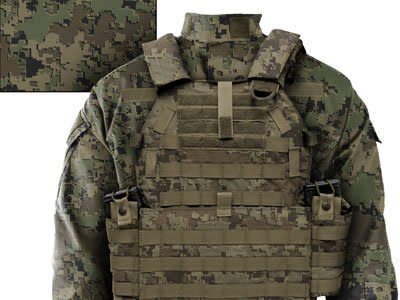After Wasting $5 Billion, the Army Is Eyeing These New Camouflage Patterns

Earlier this summer we wrote: "The U.S. Marine Corps has long been known for doing more with less; smaller, more agile, and quick to react, it actually employed that ability when hunting for new uniforms in 2002.
Erik German at The Daily tells the story of the Marines and the Army's uniform selections, mentioning a conversation he had with a textile technologist that shows the Marines flexibility and the Army's cumbersome bureaucracy.
The Marines went to their sniper school at Quantico, Va., and told a couple of their guys to find a good camouflage color for the new uniform pattern. A group of snipers went to the local Home Depot and found the main base color in the Ralph Lauren section of the paint department. The color now called Coyote Brown went into the pattern of their very successful and well-loved MARPAT uniform pattern.
This was also around the time the Army was sending its troops to Iraq with uniforms and body armor in a variety of mismatched patterns that, in effect, left U.S. soldiers wearing a target for the enemy to fire upon.
Bedder explains that in response to this and the Marines new uniforms, the general in charge of Army uniform procurement told his staff to pick a color before trials were finished.
Five billion dollars, eight years later, and the Army is now doing the whole thing again. Over the next 12 months 1.1 million soldiers will be replacing their uniforms for something called Multicam.
Hopefully this will work out better for troops, and won't have to be replaced again in a handful of years."
Now see what direction that new camo may take.
You just see the big picture and camo helps to confuse the eye

Except there's someone with a weapon.
Color schemes are chosen to mimic natural surroundings.
It's best that colors are contrasted with dark and light shades so that the wearer blends into the natural reflections and shadows we're used to seeing.
Pixels disrupt what you see and break up straight lines that did not occur in nature

Digital patterns re-create shapes found in nature, known as fractals, which we see as mere background noise.
Pixels break up the fabric into a macropattern and a micropattern, so the design doesn't appear as a solid block. Even when picked up by infrared technology, the human form is broken up and its movements are masked.
3-D Layering tricks your brain by creating depth and shadows where there may be none and refusing to allow an image to form

We interpret gradients and layers of color as a textured surface with depth. In this case, the desert.
ADS explains that the brain is deceived into regarding the fabric as part of the natural environment, rather than a solid flat surface.
Science and shadows do their part by bleeding out camo light to dark into backgrounds and help personnel blend better through patterns of light

Kryptek's example of 3-D layering features two levels: shading in the background and sharp random shapes in the foreground.
A light-reflecting gradient helps creates a three-dimensional illusion that blends into natural terrain.
There is no better designer than someone who stood out wearing bad camo — good hard R&D thinking goes on in the field

And active-duty soldiers will be field testing the Phase IV entries. The Army will then weigh the benefits and costs of adopting new camouflage.
Kryptek says their designs are made for the battlefield and the backcountry alike, so troops and civilians can both take note.
More from Business Insider:

